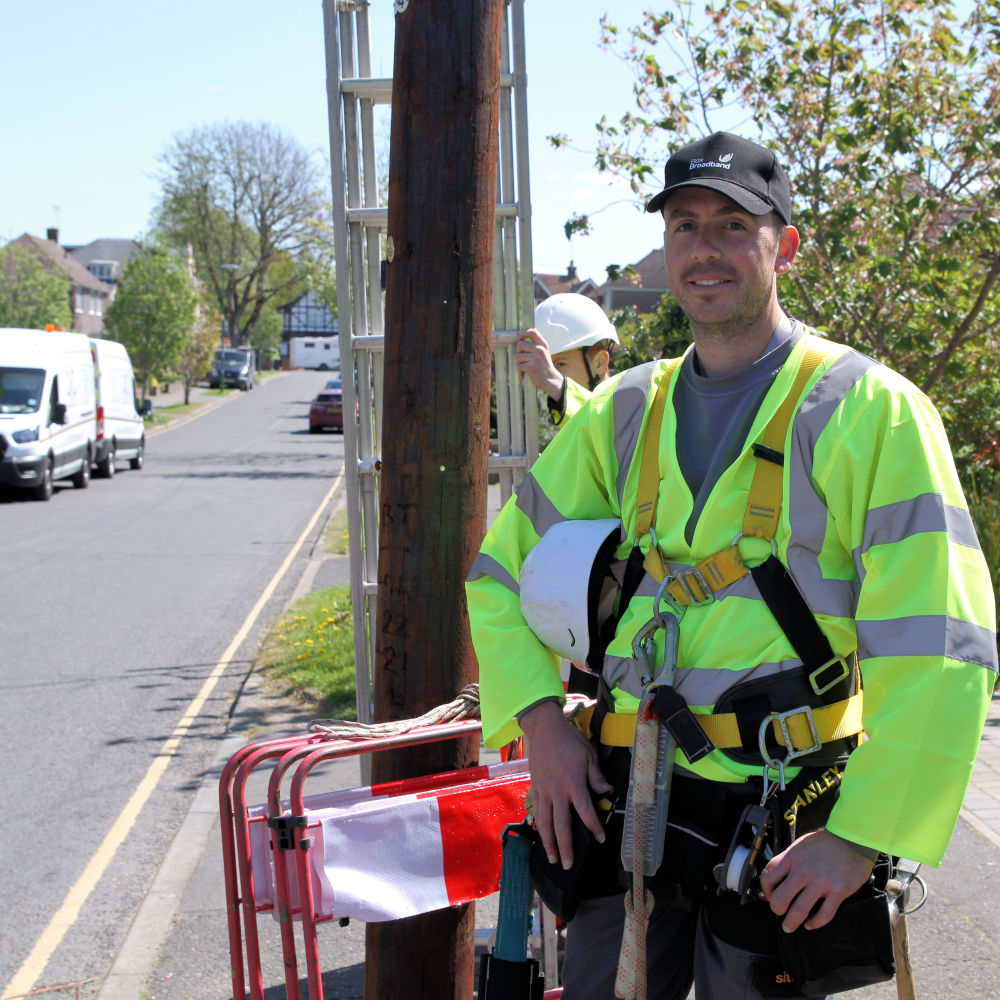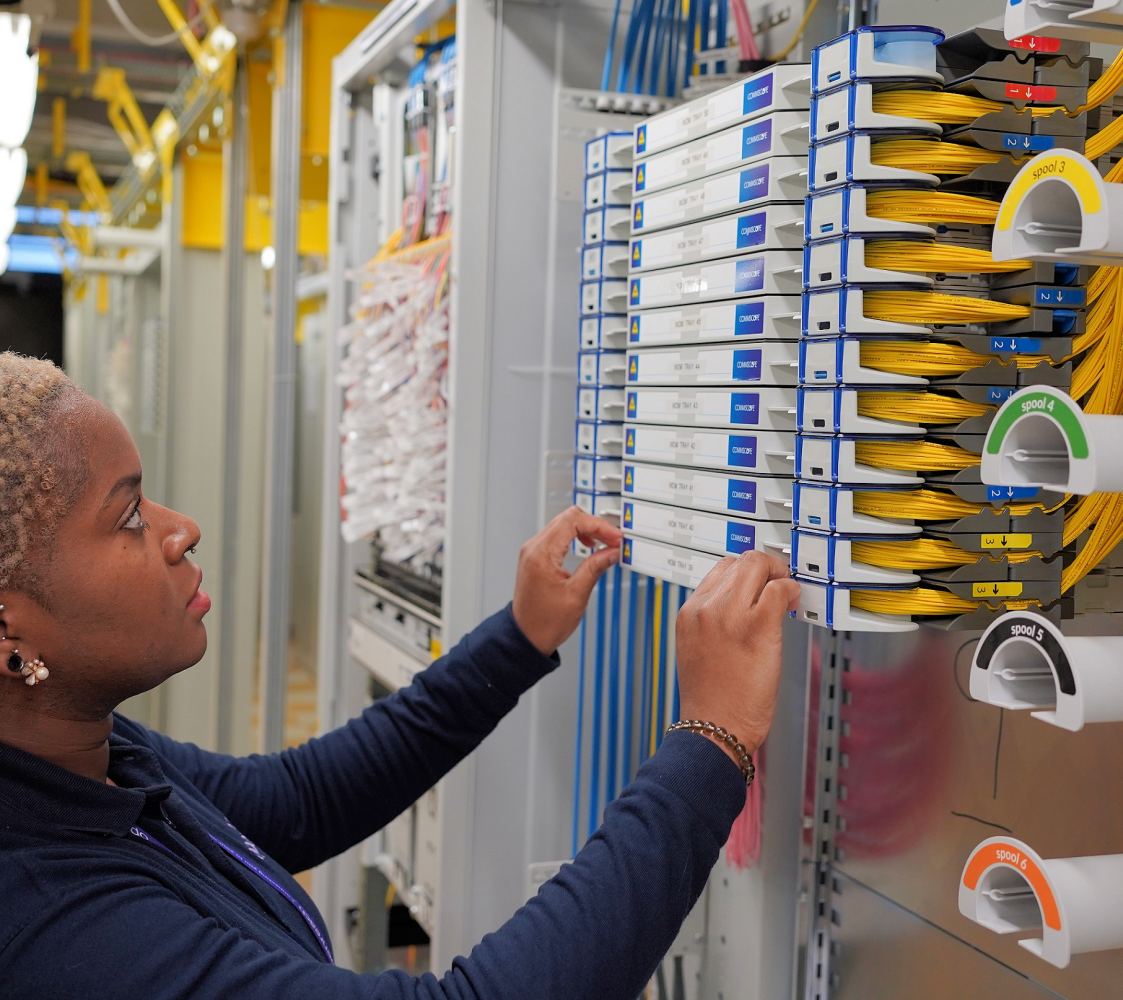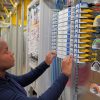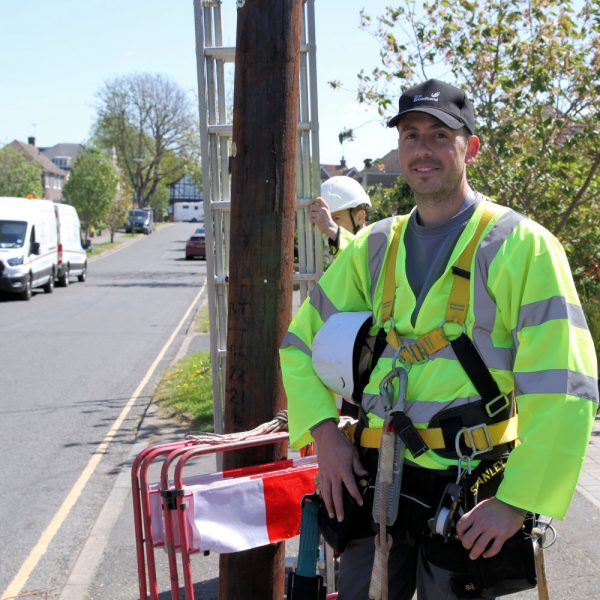Interview – How Openreach is Creating a New Fibre Infrastructure for Wales
As the engineers are rodding from box to box, if they can’t get through they first call the de-silting gang. They have a hose, which propels itself along the duct using pressurised water and tries to clear the silt. 50% of the time it gets through.
If the duct is blocked by something that can’t be moved with water, the engineers measure out with a wheel the distance from both ends. They send a report in and we get a service contractor to go out at a later date and excavate at that spot to see the damage.
Normally the contractor sees the duct is damaged. They can clean out the dirt and rubble, and work with the rodding gang to make sure they can get a sub-duct through. They put a repair collar on and they reinstate. If you’re driving along the road and you see a patch of tarmac two foot square, that’s typically a repair job.
Laying new duct
If the rodding gang have repeated blockages, that’s where we lay a whole new piece of duct. We have options. Do we have to lay it in the road, which is time consuming and delays traffic? Or can we lay duct in a verge?
We will look to using the verge instead of digging the road up. Nobody wants us to dig up the road. Digging in the grass is quicker than cutting tarmac. But sometimes the verge is full of other utilities or drainage. It’s not always possible to take the best option.
In some areas we are attempting to do mole-plough. A tractor pulls behind it a blade in the dirt. The blade ploughs the earth and behind it lays the duct. They reverse the tractor over it to smooth it all down again. Within a month you wouldn’t know they’ve been there.
Blowing the fibre
The engineers connect up the lengths of sub-duct so it’s airtight. After reach the point in the next village where they break out into a number of cabinets. They blow the fibre with pressurized air through the subduct. Because its all sealed, the air pushes the fibre through that sub-duct all the way to the end. If it’s all tidy, with good joints and no leakage of air, they can blow a good couple of kilometres.
Taking fibre up a pole or down a hole
On some of the routes fibre is up poles. It goes up the nearest telegraph pole, and spans the poles into the housing estate. Even some of the spine routes are overhead. 90% of the spine routes go underground – only about 10% go on the poles.
We have to check the poles. Sometimes trees have grown over, or the poles are old and too short.

Building the new cabinet
Work is happening to get ducts there, fibre is blown in to the high street. Simultaneously, we are trying to get the new fibre cabinet up. It’s got to be near the existing cabinet so the surveyor looks for a location. We want to avoid stuff like private land, triple SI areas [Sites of Special Scientific Interest] and areas of Outstanding Natural Beauty. They find the location, they send the paperwork into the councils, and make sure everyone is happy on the highways.
If it’s privately owned land, we approach the owner for a wayleave. If its not privately owned, like a highways-owned street, we can proceed to put the cab up.
The civil contractor builds up the base of the new DSLAM, with its duct entry points, and earthing solution. Later they drop the green cabinet on it. They lay track between the existing cabinet and the new cabinet, because you have to join the two together to extend the new fibre to the existing cabinet. One of the last activities is the power company providing the connection to the new DSLAM.
Fibre-to-the-Cabinet architecture (hybrid fibre and copper)
After all the work from enabling the exchange to blowing the fibre is done, FTTC is complete. By this point you’ve gone from the exchange, through a couple of villages, to a street cabinet and onto another cabinet.
FTTC is one of three kinds of technical architecture – there are also FTTP and FTTC-exchange only.
Fibre-to-the-Premises architecture (pure fibre optic)
If we do FTTP, we do the same journey into the town, but we don’t go to a cabinet. We use equipment sunk into a hole or up a pole. We have to go further than just to the cabinet, taking the network into a housing estate, and provide our own structures at different points to feed the different houses.
FTTC-exchange only architecture
FTTC-exchange only is a flavour of FTTC. An exchange may have copper lines leaving it directly and feeding houses in the near vicinity. We have to re-route the copper lines, and groom them into a new a cabinet. Then we put a fibre DSLAM next to the copper cabinet and connect the two together. We are putting two structures up – the copper cabinet and the DSLAM.
New remote node technology (FTTrN etc.)
A remote node piggybacks off the DSLAM. You put a DSLAM in a village with nice green, a church, a pub and all those sort of things, and all the copper is nicely central. But then you’ve got a hamlet of twenty houses a mile or two away. It will be too far away to pick up the speeds of the cabinet by the pub.
We can put a remote node in that little hamlet. A remote node needs power and fibre. It is smaller than a cabinet – it can fit down a hole or up a pole.
[ISPreview Editors Note: FTTrN is still only a trial technology]
New all-in-one cabinet technology
Rather than putting up a DSLAM and a copper cabinet, we can just put one cabinet up, and it’s all built into the same shell. In my patch in mid and north Wales, the first one of these is going up in Hundred House at the moment.
With all of these things – if its different, a new template needs to be knocked up for the base. The engineers who make it all work need training on how to put copper into it and where the fibre goes.
Direct-labour employees, contractors and subcontractors
Hundreds of people work on this project. I’ve got a team of project managers working for myself, and so does my colleague working in south Wales. Under the project managers we’ve got field coordinators. A project manager will handle a number of exchanges, and a field co-ord is his eyes and ears.
We’ve got a number of our own direct-labour employees. You see the Openreach vans driving around. Openreach guys don’t do civil engineering activities – they don’t dig any holes. Openreach do cabling work – blowing, jointing and slicing.
Openreach engineers tend to work in my own patch. Our own mid-Wales guys work out of larger exchanges like Newtown. In North Wales they are in Bangor, Chester and Oswestry.
We use a partner, Carillion telent. They subcontract out to local civil engineering firms across Wales, such as RPO Williams in Anglesey and HT Installations in Carmarthen. They are the ones who dig the holes, clear the blockages or lay some track, put the cabinets up and all that sort of work. Some of them also do cabling work.
People will see lots of engineering. It’s obvious when it’s Openreach vans, especially if they are Superfast Cymru liveried. If it’s a subcontractor doing the work, people will only know if they read the gate cards – the little laminated signs around the work.
We go everywhere
Most people will only come into contact with the Superfast Cymru project by using a postcode checker, their Facebook page or their web site. When they pass by a van, who appreciates what they are doing? Away from the consumer side, the time, money and resources required behind the scenes to lay a fibre-optic network across the country.
We go everywhere. Some people have telephones but not running water. If the water company hasn’t got to them, they are not easy to get to. But we will aim to meet the contract, so we will get to the people who haven’t got running water.
I’m proud to be part of what feels like the largest engineering project in Wales. I love this job. My grandkids wouldn’t know what it’s like to suffer with less than superfast broadband speed.
Nicholas is an an IT consultant who has worked with Internet and Enterprise technologies since the 1990s. He is writting for ISPreview.co.uk in the capacity of a guest author.
« Sky Gets TalkTalk’s Misleading “Britain’s BEST DEALS” Broadband Ad Banned
Latest UK ISP News
- FTTP (5557)
- BT (3523)
- Politics (2545)
- Openreach (2307)
- Business (2272)
- Building Digital UK (2248)
- FTTC (2049)
- Mobile Broadband (1981)
- Statistics (1791)
- 4G (1673)
- Virgin Media (1628)
- Ofcom Regulation (1470)
- Fibre Optic (1398)
- Wireless Internet (1395)
- FTTH (1382)





















































Comments are closed